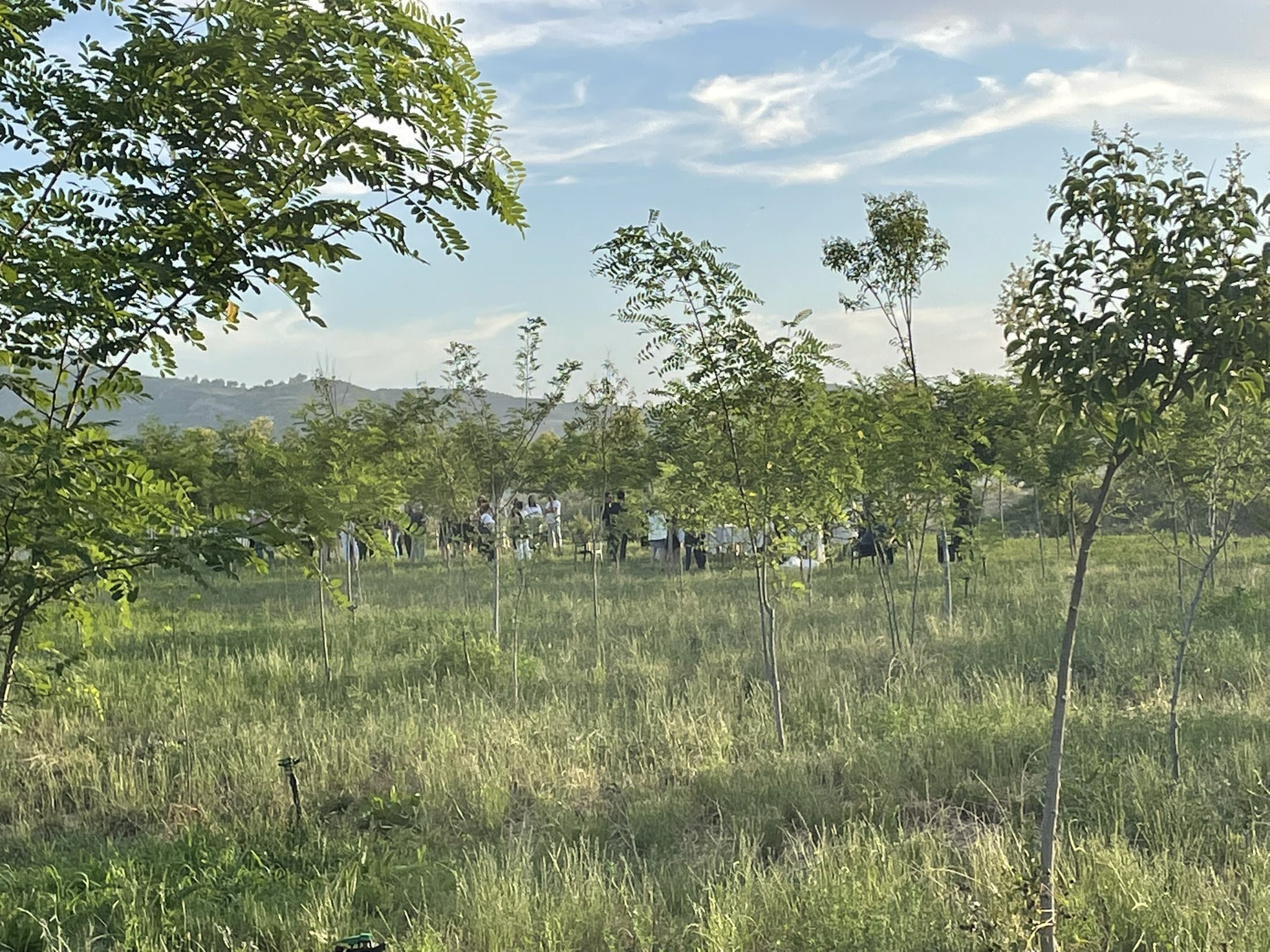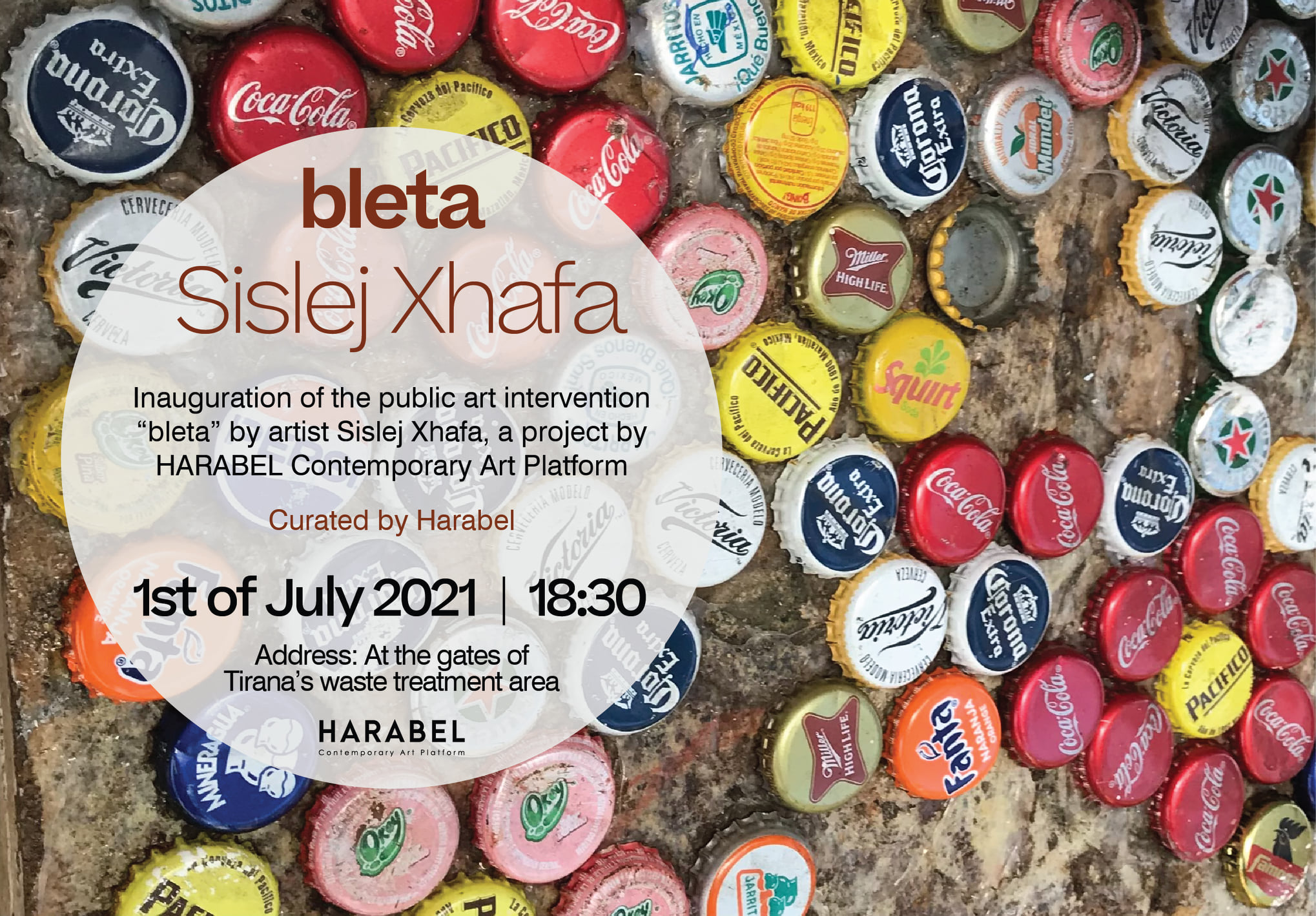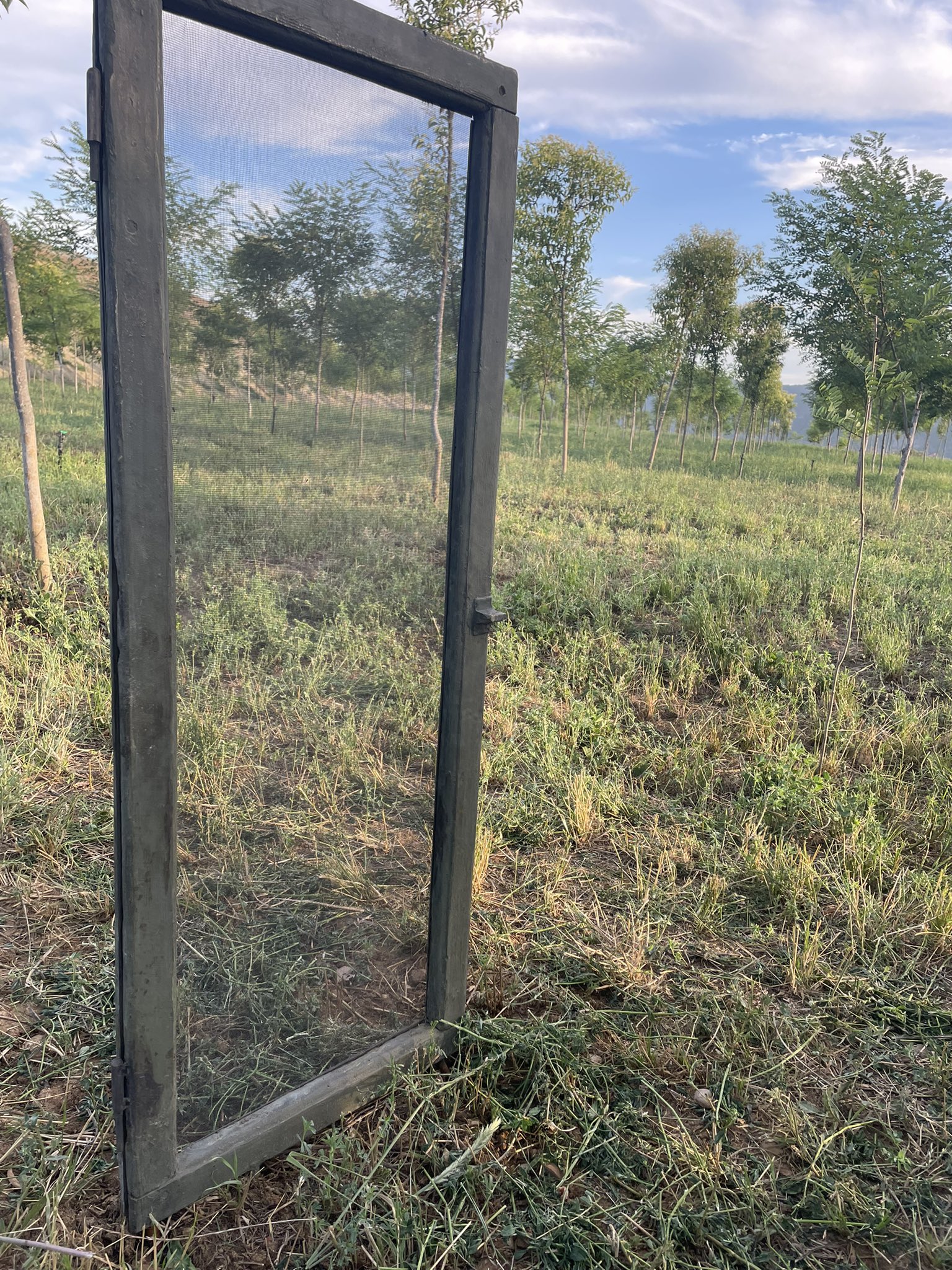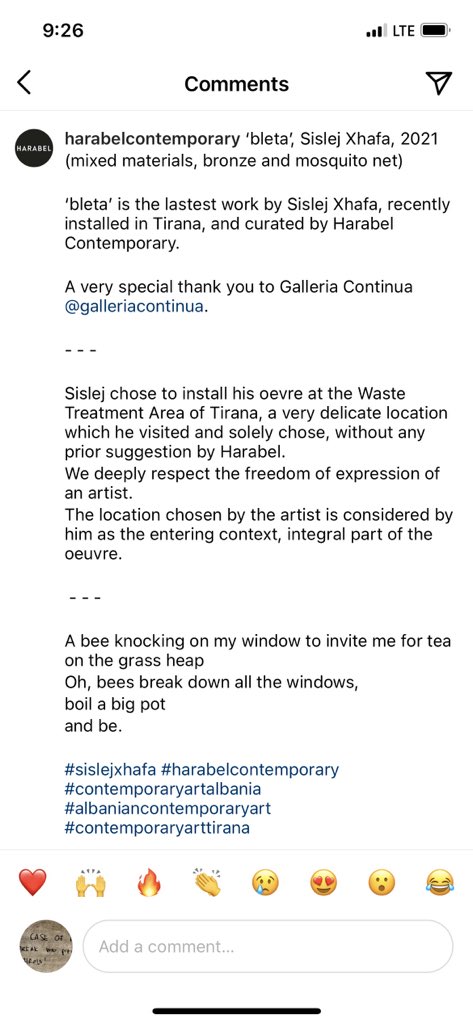
On the first of July, artists, curators, and art afficionados gathered at the gates of the Sharra landfill of Tirana to attend the inauguration of a public artwork by Kosovar artist Sislej Xhafa. The project was organized by “Contemporary Art Platform” Harabel, directed by artist Driant Zeneli and Ajola Xoxa, the wife of mayor of Tirana Erion Veliaj. The Sharra landfill has been a highly contested site, because of the killing of a child laborer, Ardit Gjoklaj, employed there by the company of a Socilialist Party leader. The confluence of art, politics, media freedom, and crime at the presentation of Xhafa’s work once again allows us to inspect the ways in which the current Albanian regime consistently attempts to use art as a façade for its policies.
Sharra
The Sharra landfill is a waste dump site under the management and responsibility of the Municipality of Tirana. In February 2016, the municipality contracted 3R shpk, a company from Peqin owned by local Socialist Party leader Edurim Teqja, to install a waste management and selection plant on the landfill. Mayor Veliaj, also from the Socialist Party, visited the plant on two occasions accompanied by his media team, touting the site as a model workplace following all legal standards and offering full insurance to its employees. He specifically invited the Roma and other underprivileged communities, who otherwise search the landfill under dismal and dangerous conditions for recyclables to sell, to become legally employed.
A few months later, on August 7, the body of 17-year-old Ardit Gjoklaj was found among the rubble at the Sharra landfill. Allegedly killed by an excavator, he turned out to be working on the landfill without proper papers or insurance. What followed was an immediate damage control campaign by the Tirana municipality that aimed at actively suppressing any news coverage of Gjoklaj’s death. Investigative journalist Artan Rama saw his show Públicus shut down by Vizion Plus, owned construction company Edil Al-It, after he investigated the incident. The company later unsuccessfully tried to sue him for slander. Journalist Alida Tota was fired from A1 News after she dedicated a news item to Gjoklaj. Meanwhile, mayor Veliaj, otherwise happy to hug children wherever he goes, hid himself from public view for several days.
Meanwhile, the judiciary failed to successfully prosecute or convict any of the responsible managers or directors of 3R. Teqja was never even officially charged. The prosecutor in charge of the case, Petrit Fusha, was photographed in December 2016, after the case had been closed, dining with mayor Veliaj. Fusha is also a family member of the owner of Fusha shpk, the favorite construction company of the Rama regime. Teqja’s license was renewed in 2019.
The death of Ardit Gjoklaj at the Sharra landfill, the subsequent suppression of the media, and the failure of the justice system are exemplary for the ways in which the current regime operates. Minors continue to die at work sites; journalists continue to be fired because of their criticism of the regime (even though multiple international press freedom organizations time and again ring the alarm, international actors such as the EU continue to turn a blind eye); and “justice” remains the purview of those with money and power, no matter how much the system is “reformed.”
Harabel
According to its website, Zeneli and Xoxa founded Harabel (“Sparrow”) in 2018 in Blloku, the former neighborhood of the communist nomenklatura, and currently the hotbed of Tirana nightlife. Harabel initially started as an operation intending to provide a centralized archive of Albanian artists and art projects, but the presence of its offices in one of the most coveted and highly priced real-estate areas of the capital immediately raised questions about its funding and goals, questions which have never been satisfactorily answered. Notably, despite claiming to be an “open archive of artists’ portfolio [sic] in Albania,” several artists and projects critical of the regime are not represented on its website. For example, Çeta, one of the most interesting public art collectives to produce work in Tirana in the last decade (including work about Gjoklaj’s death), is conspiciously absent from the Harabel platform. Since its establishment, Harabel has become a key funnel for money with unknown origins into the select part of the Albanian art scene that maintains close ties with the regime.
Zeneli had returned to Albania from Italy in 2017, and was launched into the higher regions of Albanian art-political life first as one of the few artists willing to produce work for Bunk’Art 2, as Albanian representative at the 58th Venice Biennial (no open competition was held), and as curator of the Mediterranea Biennale. Zeneli filled an important void for the Rama regime, as he was one of the few Albanian artists of his generation who returned to Albania to establish a career and didn’t openly oppose a regime that has systematically attempted to either marshall cultural life for its own propaganda purposes or defund and oppress any contrarian voices. His quick rise through the ranks of state culture can thus be attributed to his willingness to represent the regime and to collaborate in the mirage of a cultural and artistic life that I have analyzed in depth elsewhere.
Being a lawyer by profession, Xoxa has no significant background in art or culture, but her participation in Harabel clearly follows the paths laid down by the nouveau riche around the globe: after the accumulation of monetary capital (no matter how dirty) follows the accumulation of cultural capital. Even though Xoxa styles herself as “cultural promotor,” at recent events she has slid into the role of “contemporary art project creator,” despite the absence of any expertise. In the critical vacuum purposefully created and nourished by the Rama regime, mediocrity can rule supreme. We shouldn’t be suprised if she will curate the Albanian pavilion at the Venice Biennale during Rama’s third term as prime minister.
Like Zeneli and Xoxa, Harabel is very much the product of what we can call “astroturf art.” Soon after its establishment it was able to feature work by prime minister Rama’s collaborator and renowned artist Anri Sala, at the “Cloud” installation of Japanese architect Sou Fujimoto (installed in 2016, it was supposed to be a “temporary” 3-year intervention). This has been followed recently by public art installations by Adrian Paci, Alban Muja with his boho-critical “EnoughIsEnough” (what precisely is “enough”?!), and Sadik Spahija’s “Zâni,” allegedly sponsored by construction company Fusha shpk. None of these works could have been executed without government permits (no doubt furnished through Xoxa’s husband) and extensive production budgets. The access to funds and sites can only be explained by Harabel’s access to and intimate connection with the state, even though the precise nature of this connection remain obscure.
Having worked for many years as curator and activist in Tirana, I know how little money for culture is available, and how all organically grown, critical, artist-initiated projects such as Miza Galeri, Debatik Center, and Tirana Art Lab struggle financially. Public art in Tirana has a rich and contested history, yet it is the absence of conflict that makes Harabel stand out. Despite being a non-profit foundation with new offices in one of the most expensive towers of Tirana, Sky Tower, there has been no public accountability over where their money has come from and, for example, what they pay the likes of Sala and Paci for their work, work which otherwise sells for tens of thousands of euros.
Bleta

The work of Sislej Xhafa, who lives and works in New York, is called “Bleta,” or “The Bee.” The invitation to the inauguration featured a background image consisting of bottle caps attached to what looks like a dirty hardboard support. The bottle caps in the context of the title “Bee” and the location of the work immediate recall the collectors of recyclables of Tirana who scour trashbins and landfills such as Sharra to make a meager wage. They suffer under intense discrimination and racism, and are often randomly targeted by the Municipal Police for their “illegal” activities. The “Bee” here can be read as a critical metaphor for the Roma and Egyptians gathering pollen (recyclables) from the field (landfill) to bring them back to the hive (the recycling plant), a potential commentary on poverty, labor, and economy.
But once we’re confronted with the actual intervention, there seems to be very little connection with the image served as invitation. First of all, there is the environment in which the work is placed: a field covered in grass dotted with recently planted trees. This is no longer the site where a child laborer died; this is a site to be included in Italian architect Stefano Boeri‘s “orbital forest.” Even before we can attend to Xhafa’s work, we’re overwhelmed by symbolic load of the image. We have seen many shocking examples of greenwashing by Veliaj in the past: how he systematically tries to cover the thousands of abusive and corrupt building projects in the city, always preceded by illegal demolitions and expropriations, by planting trees in the outskirts, as if the foliage would provide protective shade to the millions of euros laundered by the narco maffia through construction projects. But here, on Sharra, the trees are not merely covering corruption and nepotism – here they cover death.
In this loaded context, “Bleta” takes on a problematic meaning, to say the least. First of all, we have to deal with the fact that the work is there at all. Xhafa made a conscious choice to accept the invitation to produce a public art work in Tirana facilitated and ostensibly financed by Harabel. Xhafa should have been aware of the context in which he was going to produce his art – a context in which the rich and powerful of Albania furnished him with a platform denied to so many other artists living and struggling there on daily basis.
Then there is the site itself: part of a landfill managed by a local Socialist Party leader, promoted by a Socialist Party mayor as “exemplary company,” responsible for the killing of a minor – a killing for which justice remains to be served. Furthermore, this landfill where Gjoklaj’s killing happened is, to add further insult to injury, transformed into a green space in the context of a “urban requalification” masterplan itself mired in corruption and maladministration.
And then there is the open letter, notably signed by Xhafa himself (and Paci and Muja!), published last year in art journal Hyperallergic and signed by hundreds of art workers from in- and outside Albania calling for an end to the “artwashing” of the Rama regime after the destruction of the National Theater. All of this, Xhafa and his work chose to ignore. But to ignore it, doesn’t mean it stops existing. All of the elements of the context I have sketched out above actively contribute to the meaning of the work that Xhafa chose to install in Sharra.

Let us then, finally, look at the work itself: a bronze window door with a mosquito net placed among Veliaj’s freshly planted trees. The frame of the window is missing, so we don’t know whether its door is open or closed, but one thing is certain: it is without hinges, unhinged. That the window door features a mosquito net suggests that it is a second door. In the summer, this door remains closed while opening the main window door behind it allows for the draft to pass through, keeping out the insects – not only mosquitos but also other insects, including bees. How then to think the title “Bleta” together with this mosquito door? Rather, the work seems to exclude its own title; it is an unhinged work both in the sense that the title cannot frame or support the work and that the work cannot frame or support its context. It lets the distinct air of urban waste, rot, and death pass through unobstructed while keeping out the insects essential to the cycle of life.
Naturally, Xhafa’s choice of location could not but raise a few eyebrows online, to such an extent that Harabel felt obligated to post the following addendum on social media, on July 3:
“Sislej chose to install his oeuvre at the Waste Treatment Area of Tirana, a very delicate location which he visited and solely chose, without any prior suggestion by Harabel. We deeply respect the freedom of expression of an artist. The location chosen by the artist considered by him as the entering context, integral part of the oeuvre.”
If we skip over the painful English of this prose and its framing between an acknowledgment and a poem, this is a clear example “thou doth protest too much.” The organizers insist twice that Xhafa (“Sislej,” as they refer to him) selected the site by himself, even though they seem to be aware that this location is “very delicate.” This is hard to believe, as on the website of Xhafa’s project, Harabel claims that his work is the first of a series of public works to turn the Sharra landfill park into a “contemporary art sculpture park.” This long-term curatorial plan is difficult to square with Xhafa’s supposed sole choice “without any prior suggestion by Harabel.”

Zeneli and Xoxa also fail to explain why the site is indeed “very delicate” and how Xhafa’s work responds to that. Rather, they abdicate any responsibility for the artistic process and dump it all on artist’s “freedom of expression.” Without a doubt, Xhafa may lay claim to such freedom, but it is the curating agency’s responsibility to see the broader context and implications of situating a public artwork at a specific location. This is the entire point of curating public art and any institution unaware of such a basic premise should not be taken seriously. “Respect for the freedom of expression of an artist” is a not a free pass for complete negligence. Either Harabel didn’t inform Xhafa about the “very delicate” nature of the site and allowed his work to be crushed by its context, or Xhafa placed his work being consciously aware of the “very delicate” nature of the site, in which case we should seriously question his intentions and moral judgment, especially considering the fact the site has now become “private property” and his work is technically speaking not even public! Without a more extensive statement by either Xhafa or Harabel, no clarity can be gained on this point.
The poem accompanying the social media post, which also accompanies the announcement of the work on the website, however, may shed some further light on Xhafa’s artwork:
A bee knocking on my window to invite me for tea on the grass heap
Oh, bees break down all the windows,
boil a big pot
and be.
The poem refers to the “Bleta” of the title, the location of the work (“grass heap”), and its form (once you “break down all the windows,” you only have the mosquito net left). As is often the case in contemporary art, the written discourse accompanying it – be that a poem, title card, or other forms of “text” – does all the conceptual heavy lifting here. The poem frames the scene of invitation, with the harabel (“sparrow”) replaced with the bletë (“bee”). The bee invites the artist “for tea on the grass heap.” Anyone with the slightest familiarity with internet culture knows that “tea” has become a widely used synonym for “truth,” as in “serving the tea/truth.” The bee/sparrow thus invites the artist for tea/truth on the grass heap, an obvious reference to the park created by Veliaj on the Sharra garbage heap. But the truth is never served. Instead, the bee and his friends “break down all the windows” until only the window door with the mosquito net is left, a faux transparency that continues to block any real passage. They boil a “big pot” of tea and then just “be,” the tea left on the furnace, boiling over.
Apart from the admonition to resign yourself, to “just be,” that wants to absolve the artist or curator from any form of responsibility for their own work, what should pique our attention is the ungrammaticality of the usage of “be” where the verbal form “are” would be expected. Who or what is this “are” or “R”? Would it be a stretch to read in the slip from “are” to “be” a suppression of the big R of Albania, Rama? And then what about the “be” or “B” that was written instead? Besides being an obvious pun on our protagonist “bee,” which “B” should we have here in mind? Boeri, the corrupt architect of Tirana’s orbital forest? The B of the Balkans perhaps, where the practices described in this analysis continue to reign supreme? Or maybe, very simply, the B of bullshit: the trash on which the work is literally erected, the crap of the faux-artistic elite brouhaha of Harabel that surrounds it, and the terrible stench that’s emitted by a “public” art work masking a monstrous injustice with a smart little verse.


